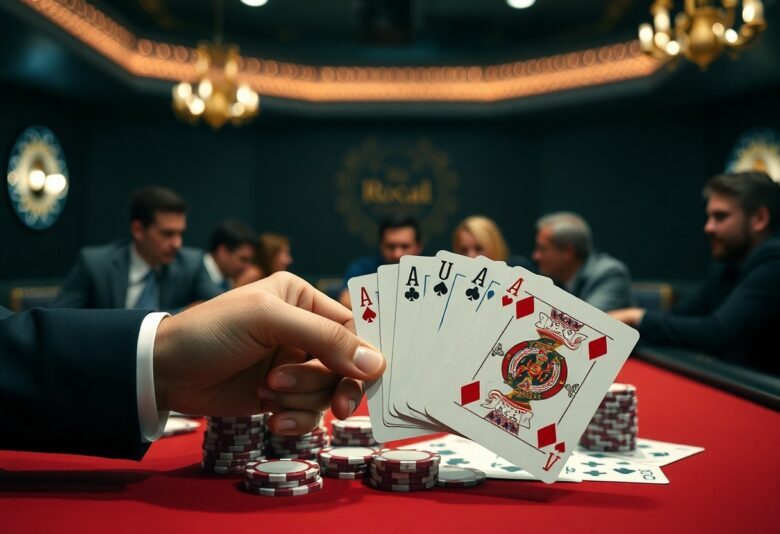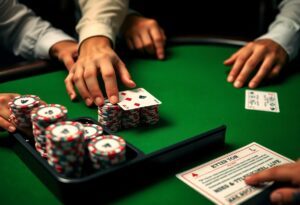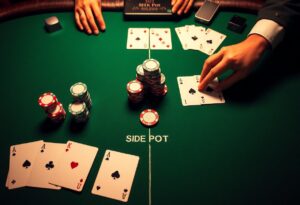Bluffing is an crucial skill in poker that, when executed correctly, can significantly tilt the odds in your favor. Understanding when to bluff, the type of players to target, and how to read your opponents can lead to substantial gains. Effective bluffing involves creating a convincing narrative that can manipulate opponents’ perceptions while also managing your own table image. This post explores various strategies that can enhance your bluffing technique, ensuring you play with confidence and intent, ultimately elevating your game.
Understanding Bluffing
Bluffing isn’t just about deception; it’s a vital skill that reflects a player’s ability to read opponents and adapt strategy accordingly. Successful bluffing involves assessing not only your own hand but also the perceived strength of your opponents’ hands. The best bluffers blend confidence with subtlety, maintaining a calm demeanor while implementing tactics that can disrupt opponents’ expectations, often required when the situation calls for it. Mastering this balancing act is vital for consistently outmaneuvering rivals at the table.
The Psychology of Bluffing
Understanding the psychology behind bluffing reveals why some players excel while others falter. Bluffing effectively taps into opponents’ emotions, exploiting their fears and overconfidence. An adept bluffer reads telltale signs—shifts in posture, facial expressions, or even betting patterns. For instance, a sudden large bet can evoke nervousness, potentially causing opponents to fold despite having better hands. This psychological warfare, when wielded skillfully, transforms bluffing into a powerful tool for manipulating the flow of play.
When to Bluff vs. When to Fold
Timing is everything in poker, especially in deciding when to bluff or fold. Successful bluffs typically occur in situations where the potential payoff outweighs the risk, such as against multiple opponents or when the board presents opportunities to disguise a strong hand. Conversely, folding should be prioritized in spots where the odds of being caught are high. Assessing the table dynamics, stack sizes, and previous betting trends helps navigate these pivotal decisions more effectively.
Recognizing specific moments to bluff can markedly influence your success rate. For instance, bluffing in late position against fewer opponents often works better due to the limited information they possess, making them more prone to folding. In contrast, bluffing against tight players who only bet strong hands can be perilous. Noticing players’ tendencies and adjusting your strategy accordingly allows you to maximize the benefits while minimizing risks. Balancing aggression with caution in these scenarios develops a more sophisticated and effective bluffing strategy.
Types of Bluffs
Different types of bluffs can be employed depending on the situation and your read on opponents. Understanding these bluffs can significantly enhance your game. Below is a breakdown of the two primary bluff types:
- Pure Bluff
- Semi-Bluff
- Stone Bluff
- Continuation Bluff
- Value Bluff
After mastering these types, players can choose the appropriate strategy to maximize their chances of success.
| Type of Bluff | Description |
|---|---|
| Pure Bluff | A bet or raise with a hand that cannot win. |
| Semi-Bluff | A bet with a drawing hand that may improve. |
| Stone Bluff | A bluff against opponents with strong hands. |
| Continuation Bluff | A bet after being the aggressor pre-flop. |
| Value Bluff | A bet to extract value while hiding strength. |
The Pure Bluff
The pure bluff represents the ultimate act of deception in poker. This strategy entails betting or raising with no possibility of winning if called, relying solely on the hope that opponents will fold better hands. Effective pure bluffs are often executed in situations where the board texture favors bluffing, such as when it shows high cards or possible straight or flush draws. The key is to assess your opponents’ tendencies and psychological profiles to pinpoint when your bluff will hold the most weight.
The Semi-Bluff
A semi-bluff involves betting or raising with a hand that has potential to improve, even if it is not currently the best hand. For instance, you might hold a flush draw or an open-ended straight draw, and by betting, you might either force opponents to fold or improve your hand on the next card. This strategy is particularly effective because it allows you to represent strength and maintain some equity in the hand. Recognizing when to implement a semi-bluff requires keen observation of opponents’ betting patterns and the evolving dynamics of the game.
Applying the semi-bluff strategically can confuse opponents; they may interpret your aggression as strength while knowing you have options for improvement. This tactic capitalizes on both the immediate pressure to fold and the potential for a later strong hand, crafting a dual layer of threat. Successful players often time their semi-bluffs to coincide with favorable board developments, enhancing the illusion of strength while retaining the chance to catch up if called.
Timing Your Bluff
Executing a bluff at the right moment can transform the outcome of a hand. The timing relies on various factors, such as the betting patterns observed and the flow of the game. Bluffs are often most effective during late stages when the stakes are high, and players are more likely to fold under pressure. Practicing patience and choosing the opportune moment can lead to a higher success rate and create a strong image of assertiveness at the table.
Positioning and Table Dynamics
The player’s position at the table significantly affects the success of a bluff. Sitting in a late position allows for better insight into opponents’ actions, providing an edge to choose when to execute a bluff. Understanding table dynamics—how players react, their tendencies, and stack sizes—creates opportunities to exploit advantageous moments for bluffing. For instance, targeting a player who frequently folds to aggression can yield profitable results.
Reading Opponents
Reading opponents effectively involves observing betting patterns, physical tells, and other cues during gameplay. Players should analyze whether opponents approach the game conservatively or aggressively, as this influences the potential for successful bluffs. A player who tends to play tight may be more susceptible to a well-timed bluff, especially if their behavior indicates uncertainty. A simple shift in posture or facial expression, such as a quick glance at chips, can reveal their thoughts and help determine the right moment to create pressure.
Executing the Bluff
Executing a successful bluff involves a combination of timing, awareness of the table dynamics, and knowing when to apply pressure. A well-timed bluff can capitalize on opponents’ tendencies and misreads, ultimately leading to a favorable outcome. Confidence in your play and body language sends a signal of strength, which can often pressure your opponents into folding. Understanding your position at the table and the betting patterns of your opponents enhances your decision-making when choosing to bluff.
Bet Sizing Techniques
Effective bluffing hinges on bet sizing, as the amount wagered can convey a narrative about your hand. A small bet may suggest weakness, while a hefty wager can indicate strength. Ideally, aim for a bet size that closely mimics your standard strong hands. For instance, betting around 70-90% of the pot can create the illusion of a robust hand, pushing opponents to reconsider their position, especially if they are holding marginal holdings.
Telling a Convincing Story
Every bluff must tell a convincing story that aligns with the actions taken throughout the hand. A coherent narrative can lead opponents to perceive your bet as a representation of a strong hand. For example, if you’ve been playing aggressively, a large bet after a key board card appears provides context for a legitimate high hand. Contrasting behaviors, like suddenly becoming passive after an aggressive start, can raise suspicion and may result in your bluff failing.
In developing a convincing storyline, consider how your prior actions create a cohesive picture of your hand. If you’ve made a series of aggressive plays pre-flop and on the flop, a sizable river bet appears consistent with strong holdings. Detail your behavior to align with the community cards revealed, such as suggesting you’ve completed a flush or straight. Observing and adapting to opponents’ reactions also aids in reinforcing this narrative, increasing the chance they will fold when faced with your bet.
Common Bluffing Mistakes
Bluffing can backfire if players fall into common traps. Overconfidence, poor reads, or a lack of understanding of table dynamics can lead to costly errors. Recognizing these pitfalls helps refine bluffing strategies and enhances overall gameplay effectiveness.
Overbluffing
Overbluffing often leads to predictable outcomes. Players who frequently attempt to bluff end up diluting their credibility, making their remaining bluffs less effective. This pattern can cause opponents to call with weaker hands, as they sense an opportunity to exploit the tendency.
Failing to Assess Opponent’s Tendencies
Not paying attention to an opponent’s behavior can result in missed opportunities. Evaluating their previous actions, whether they’re tight or loose players, is necessary for effective bluffing. A player who consistently folds to aggression presents different bluffing opportunities than one who calls down frequently.
Ignoring your opponent’s tendencies can lead to flawed bluffing decisions. For example, if you attempt to bluff a player known for calling down lightly, odds are high they won’t fold, resulting in wasted chips. Conversely, a player who frequently folds will be an easier target for a well-timed bluff. Always observe betting patterns and player psychology; leveraging this information will significantly enhance your bluffing strategy, fostering more profitable outcomes in the long run.
Advanced Bluffing Strategies
Deploying advanced bluffing strategies enhances a player’s ability to manipulate the game. Key techniques include understanding opponent tendencies, utilizing reversed tells, and selecting optimal spots to execute bluffs. Prioritizing the right moments and leveraging pot odds can lead to successful outcomes.
- Analyze opponent behavior patterns.
- Employ reversed tells to mislead opponents.
- Capitalize on position and table dynamics.
- Understand betting patterns for effective bluffing.
- Use blockers to inform bluffing decisions.
| Strategy | Description |
|---|---|
| Opponent Analysis | Study how opponents react to various actions. |
| Reversed Tells | Give off signals that suggest a strong hand when bluffing. |
| Position Play | Use positional advantage to influence pot sizes. |
| Betting Patterns | Interpret opponent bets to identify bluffing opportunities. |
| Blockers | Leverage specific card holdings to support bluffing. |
Bluffing in Tournaments vs. Cash Games
Tournament environments require a different approach to bluffing compared to cash games. In tournaments, maintaining chip stack size and facing shorter-handed play can amplify bluffing opportunities, while cash games may allow smaller, more frequent bluffs due to deeper stacks.
Leveraging Image and Reputation
Your table image can significantly influence the effectiveness of your bluffs. Players with a tight image often have more success bluffing as opponents assume they hold strong hands, making it easier to force folds. Conversely, a loose image can hinder a player’s ability to bluff, as opponents may call more frequently, anticipating weaker hands.
Leveraging image and reputation opens doors for strategic play. For example, a player known for being aggressive can utilize this to their advantage by executing well-timed bluffs, as opponents might be inclined to call knowing they usually play aggressively. Conversely, cultivating a tight image allows for more covert bluffing but requires careful consideration of how past actions affect future decisions. The balance rests in how well you can manipulate your perceived strength at the table while remaining unpredictable in your play style.
Final Words
Drawing together effective bluffing strategies in poker reveals the fine balance between psychology and mathematics. Successful bluffing hinges on timing, understanding opponents, and reading the table dynamics. By applying situational awareness and practicing controlled aggression, players can enhance their bluffing game. Tailoring your approach based on player types allows for more calculated risks and increases your chances of success. Mastering these strategies can significantly elevate your poker skills, ultimately leading to a more formidable presence at the table.
FAQ
Q: What are the most effective bluffing strategies in poker?
A: Effective bluffing strategies include tight aggression, where you play fewer hands but bet aggressively; semi-bluffing, where you bet with a drawing hand that can improve; and recognizing the right moments to bluff based on opponents’ tendencies and table dynamics.
Q: How can I identify the best opportunities to bluff?
A: Best opportunities to bluff can be identified by observing opponents’ betting patterns, position at the table, and the texture of the board. Bluff when you have a tight image, when the board is favorable for strong hands, and when your opponents show weakness.
Q: What should I avoid when attempting to bluff?
A: Avoid bluffing against multiple opponents, bluffing too often, and using large bet sizes without a strong rationale. Also, do not bluff when there are many potential strong hands that could beat yours, or when your opponent has shown strength in their betting.




